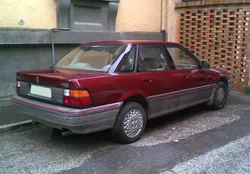

Rover 200 Generation 2 R8 Facelift 1994 Features
Discover the features of the Rover 200, focusing on the Generation 2 R8 facelift from 1994. Explore its design and specifications now!
The Rover 200 Generation 2, known as the R8, made its debut in the late 1980s, with its facelifted version being launched in 1994. This generation of Rover aimed to symbolize British craftsmanship and...
History and Features
Mycarro AI
Apr 27, 2025
The Rover 200 Generation 2, known as the R8, made its debut in the late 1980s, with its facelifted version being launched in 1994. This generation of Rover aimed to symbolize British craftsmanship and design excellence, while also embracing the modern automotive advancements of the time. The R8 was produced until 1999, during a crucial transition period for the Rover brand.
Design and Aesthetics
The R8 showcased a more rounded appearance compared to its predecessor, with an aggressive yet elegant demeanor. The facelift in 1994 introduced refined elements that further modernized its look. The front fascia was revamped with a new grille and headlights, giving the car a contemporary feel. The design team meticulously focused on aerodynamics, and the R8’s shape not only improved fuel efficiency but also enhanced driving dynamics.
Inside, the Rover 200 offered a spacious cabin equipped with sophisticated materials and user-friendly controls. The facelift saw an upgrade in the quality of materials used for the dashboard and seating, elevating the overall ambiance of the interior. The layout was designed to accommodate both driver and passengers comfortably, showcasing a blend of style and function.
Performance and Engine Options
Under the hood, the Rover 200 R8 facelift provided a variety of engine options, meeting the diverse preferences of car buyers in the 1990s. The range included petrol engines that varied in displacement from 1.1 to 1.8 liters, allowing customers to select between performance and fuel efficiency. The 1.4-litre engine became particularly popular, balancing a good power output with reasonable running costs.
The 1.8-litre version, known for its spirited performance, appealed to enthusiasts seeking a livelier driving experience. Transmission options included both manual and automatic, catering to a variety of driving styles. Additionally, the introduction of the turbocharged engines aimed to further enhance performance figures while maintaining the iconic Rover smoothness.
Features and Technology
As automotive technology progressed, the Rover 200 R8 incorporated several features that were ahead of its time. The facelift model introduced advanced safety features that included airbags and anti-lock brakes, which were becoming increasingly important to customers. The introduction of electronic power steering made driving more effortless, providing a positive steering feel without compromising on responsiveness.
Technological advancements in infotainment were also showcased in the R8, with optional features such as CD players and upgraded audio systems making their way into the car. Such amenities helped the Rover 200 cater to a younger demographic that sought novelty along with reliability.
Market Performance and Legacy
Upon its launch, the Rover 200 R8 received positive reviews, making it a competitive choice among compact cars in the late 1990s. Despite stiff competition from manufacturers like Ford and Volkswagen, the R8 managed to carve out a substantial market segment thanks to its unique blend of style, performance, and British heritage.
The R8 also laid the groundwork for subsequent Rover models, helping the brand evolve throughout the 1990s. Although it faced challenges following the dissolution of the British Leyland group, the R8 has remained a favorite among enthusiasts and classic car collectors. Its design ethos and innovative features continue to be appreciated in contemporary automotive discussions.
Conclusion
The Rover 200 Generation 2 (R8) facelift of 1994 stands as a testament to British automotive ingenuity. With its striking design, varied engine options, and advanced technology for the time, it certainly marked a significant milestone for Rover as they transitioned into the more competitive automotive landscape of the 1990s. The legacy of the R8 lives on among car enthusiasts who admire its distinctive characteristics and nostalgic connection to a bygone era of motoring.
